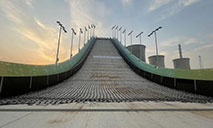China's Shenzhou-13 astronauts to conduct extravehicular activities

Screen image captured at Beijing Aerospace Control Center in Beijing, capital of China, Oct. 16, 2021 shows three Chinese astronauts, Zhai Zhigang (C), Wang Yaping (R) and Ye Guangfu, waving after entering the space station core module Tianhe. (Xinhua/Tian Dingyu)
BEIJING, Nov. 5 (Xinhua) -- China's Shenzhou-13 astronauts will conduct extravehicular activities (EVAs) for the first time in the next few days, announced the China Manned Space Agency (CMSA) on Friday.
Three Chinese astronauts have been working and living in orbit for 21 days since they were sent into space onboard the Shenzhou-13 spaceship and entered the combination of the country's space station on Oct. 16, said the agency.
The three astronauts are currently in good condition, and the combination is operating stably. All conditions for the crew's first EVAs are in place, the CMSA said.
The combination of China's space station is formed by the Shenzhou-13 spaceship, Tianhe core module, and cargo crafts Tianzhou-2 and Tianzhou-3.
 Screen image captured at Beijing Aerospace Control Center in Beijing, capital of China, Oct. 16, 2021 shows China's Shenzhou-13 crewed spaceship having successfully docked with the radial port of the space station core module Tianhe. (Xinhua/Tian Dingyu)
Screen image captured at Beijing Aerospace Control Center in Beijing, capital of China, Oct. 16, 2021 shows China's Shenzhou-13 crewed spaceship having successfully docked with the radial port of the space station core module Tianhe. (Xinhua/Tian Dingyu)
Starting from Oct. 16, three Chinese astronauts embarked on the country's longest-ever crewed mission for space station construction.
The three astronauts are Zhai Zhigang, the commander and China's first spacewalker; Wang Yaping, the first female aboard China's space station; and Ye Guangfu, a newcomer to space.
Over the 21 days in space, the astronauts performed their daily work, including transferring supplies from the cargo craft, managing the space station combination, testing new EVAs spacesuits, in-orbit medical checks, weightlessness protection exercises, and space experiments.
The crew also carried out in-orbit training programs such as emergency evacuation, mechanical arm operation, and medical rescue drills.
Photos
Related Stories
Copyright © 2021 People's Daily Online. All Rights Reserved.










